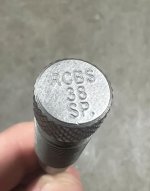3rdgeargrndrr
Member
- Joined
- Apr 5, 2014
- Messages
- 1,162
- Reaction score
- 1,193
My original post got deleted somehow so I hope this isnt a repost.
So I am loading 357 again, full house loads w/ W296.
The question is, what is meant by heavy roll crimp?
It seems to be subjective. Maybe its covered in the Lyman manual- I should go back over that.
To me “heavy” is an additional 1/2 turn once die meets case mouth and “light” is quarter turn on my Lee die.
The XTP still spins freely in the case once crimped.
My loads dont back out when shooting.
What does the wolf pack say?
So I am loading 357 again, full house loads w/ W296.
The question is, what is meant by heavy roll crimp?
It seems to be subjective. Maybe its covered in the Lyman manual- I should go back over that.
To me “heavy” is an additional 1/2 turn once die meets case mouth and “light” is quarter turn on my Lee die.
The XTP still spins freely in the case once crimped.
My loads dont back out when shooting.
What does the wolf pack say?

